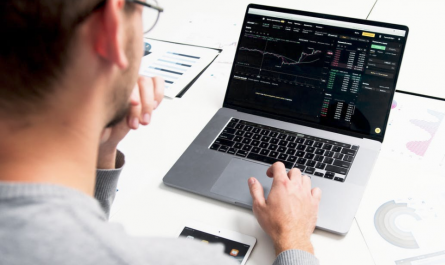Understanding the Basics of a Blockchain Wallet
In the ever-evolving world of cryptocurrency, understanding the mechanisms that protect and facilitate your digital transactions is crucial. One such mechanism is the blockchain wallet, an indispensable tool in the realm of digital currencies. At its core, a blockchain wallet acts as a digital counterpart to traditional wallets, allowing users to securely store, send, and receive digital currencies like Bitcoin, Ethereum, and many others. But what sets a blockchain wallet apart from your everyday wallet is its ability to offer enhanced security, unparalleled accessibility, and a level of anonymity that is frequently sought after in the digital age.
Blockchain Wallet vs. Traditional Wallets
While both blockchain wallets and traditional wallets serve the fundamental purpose of storing assets, their operational dynamics differ significantly. Traditional wallets typically deal with physical currencies and are limited by geographical and institutional restrictions. On the other hand, blockchain wallets transcend these limitations by operating in a decentralized digital ecosystem. This ensures that transactions are not only faster and more efficient but also globally accessible irrespective of borders or banking hours.
Key Features and Benefits
Blockchain wallets boast a range of features that make them highly attractive to both seasoned traders and crypto newcomers alike. Security is a hallmark of these wallets, leveraging advanced cryptographic techniques to protect user assets against fraud and unauthorized access. Additionally, blockchain wallets provide a greater degree of anonymity, which is a compelling attribute for those valuing privacy in their financial dealings. Moreover, they offer unparalleled accessibility, enabling users to manage their assets anytime and anywhere, as long as there’s an internet connection.
As digital currencies continue to gain traction, familiarizing oneself with blockchain wallets and their functionality not only enhances one’s understanding of this transformative technology but also provides the tools necessary to engage with it securely and effectively.
What is a Blockchain Wallet?
In the ever-evolving landscape of digital finance, understanding the concept of a blockchain wallet is crucial for anyone interested in cryptocurrency. A blockchain wallet serves as a digital tool to manage cryptocurrencies like Bitcoin, Ethereum, and many others. It allows users to store, send, and receive digital currency securely and efficiently, using blockchain technology as its underlying foundation.
The Concept and Essential Functions
At its core, a blockchain wallet functions similarly to traditional bank accounts, but with a decentralized twist. It does not physically store currency but provides tools for interacting with the blockchain network where transactions are recorded and managed securely. The primary functions of a blockchain wallet include:
- Storage: Safely storing the encrypted digital keys needed to manage and access cryptocurrencies.
- Transaction Management: Sending and receiving digital currency with ease across the globe.
- Monitoring: Accessing real-time information on your cryptocurrency holdings and transaction history.
Difference Between Blockchain Wallet and Traditional Wallets
Understanding the distinction between blockchain wallets and traditional wallets is imperative. A traditional wallet, whether physical or digital (as in mobile banking apps), typically holds your government-issued currency and allows for transactions within a regulated financial system. It is tethered to financial institutions and subject to geographical limitations.
In contrast, a blockchain wallet operates in a decentralized environment, free from the confines of conventional banks. This setup allows users to perform peer-to-peer transactions beyond borders without intermediaries. Additionally, since blockchain wallets do not physically store the cryptocurrency but instead manage keys for access, the element of storage differs fundamentally from that of traditional wallets.
Key Features and Benefits
The blockchain wallet is laden with remarkable features which make it an indispensable tool for anyone interested in the dynamic world of digital currencies. Here are some key advantages:
Security
Blockchain wallets provide enhanced security features thanks to cryptographic techniques involved in blockchain technology. Each wallet includes private and public keys that resemble the function of a password and account number, respectively. While the public key is used to receive funds, the private key is necessary to access and manage your wallet, ensuring that transactions can only be made by authorized users.
Accessibility
With blockchain wallets, users enjoy unparalleled accessibility. Transactions can be made anywhere globally, as long as you have internet access. This aspect of accessibility disrupts traditional banking systems which may impose geographical and temporal constraints. Users are also able to monitor and manage their holdings with mobile or web-based applications, offering a holistic financial overview at their fingertips.
Anonymity
One of the prominent benefits of using a blockchain wallet is the level of anonymity it offers. While transactions are publicly logged on the blockchain, personal information is not inherently tied to the wallet address. This allows users to conduct financial activities with greater privacy compared to conventional financial systems, which require personal identification and are subject to scrutiny and regulation.
In conclusion, the blockchain wallet is a groundbreaking financial tool that offers high levels of security, global accessibility, and anonymity. Its emergence marks a substantial shift from traditional banking systems towards a more decentralized and democratized financial ecosystem. Understanding the fundamental elements and excellent benefits of blockchain wallets is essential for anyone venturing into the realm of digital currencies.
How Does a Blockchain Wallet Work?
The intricate workings of a blockchain wallet are fundamental to understanding digital currency management. Blockchain wallets operate within a decentralized system, connecting users to the broader network where cryptocurrency transactions take place. Unlike traditional banking operations, blockchain wallets utilize a system of cryptographic keys to facilitate secure and transparent transactions.
The Mechanics Behind a Blockchain Wallet
At its core, a blockchain wallet is designed to manage blockchain accounts and send, store, and receive digital currencies. It operates through a series of complex algorithms that ensure secure transactions. When a user initiates a transaction, their blockchain wallet interacts with the blockchain network, producing a transaction record that cannot be altered once confirmed, ensuring both security and immutability.
One of the key features of a blockchain wallet is its ability to connect users directly to the blockchain, bypassing the need for third-party intermediaries found in traditional financial systems. This significantly boosts transaction speed and reduces costs, two vital elements contributing to the popularity of blockchain solutions.
The Role of Public and Private Keys
Public and private keys are fundamental components of blockchain technology, ensuring security and privacy in digital transactions. Each blockchain wallet is powered by these cryptographic keys, each serving a distinct purpose.
Public Key: This key can be shared openly. It acts as an address or location on the blockchain, similar to a bank account number. When someone wants to send you cryptocurrency, they use your public key. The transparency of the public key allows for quick and efficient selection of the recipient in the blockchain network.
Private Key: The private key, conversely, must remain confidential. It is essentially a password or a digital signature that permits you to access your funds and authorize transactions. The security of your blockchain wallet heavily relies on the protection of your private key; losing it may result in the loss of access to your funds.
Different Types of Blockchain Wallets
Blockchain wallets come in various forms, each offering different levels of security, accessibility, and convenience. Understanding the distinctions between hot, cold, and hardware wallets can aid users in selecting the best option tailored to their needs.
Hot Wallets
Hot wallets are wallets that are connected to the internet. They are known for their convenience and ease of use, making them suitable for everyday transactions. Hot wallets can be either web-based or app-based, providing users with the flexibility to manage their funds effortlessly. However, due to their constant connection to the internet, they are more susceptible to online threats such as hacking and phishing attacks.
Cold Wallets
Cold wallets, or offline wallets, offer a higher level of security by storing cryptocurrencies away from internet access. By being disconnected from online environments, they minimize the risks associated with cyber threats. Cold wallets are ideal for long-term storage of large amounts of cryptocurrency that do not require frequent access.
Hardware Wallets
Hardware wallets provide the ultimate combination of security and ease of access. They are physical devices, similar to USB drives, that store both your public and private keys securely and offline. To conduct a transaction, you connect the hardware wallet to an internet-capable device, ensuring minimal exposure to online threats. This type of wallet is highly recommended for users looking to secure large investments in cryptocurrency.
By understanding the mechanics, key components, and various types of blockchain wallets, users can better navigate the digital asset landscape. Choosing the appropriate wallet type, appreciating the role of public and private keys, and understanding operational security can significantly enhance the overall blockchain wallet experience, ensuring users can confidently manage their digital currencies.
How to Secure Your Blockchain Wallet
Best Practices for Securing a Blockchain Wallet
In the evolving world of digital finance, maintaining the security of your blockchain wallet is paramount. A blockchain wallet’s primary function is to safeguard your digital assets, ensuring they remain accessible only to you. Employing best practices for security not only helps in protecting these digital currencies but also provides peace of mind in an ever-changing digital landscape.
One of the cornerstone strategies for enhancing your blockchain wallet’s security is using strong, unique passwords. A robust password typically comprises a mix of uppercase and lowercase letters, numbers, and special characters. It’s crucial to avoid easily guessed phrases such as birthdays or common words, as these can be susceptible to brute force attacks.
Two-factor authentication (2FA) adds an additional layer of security to your blockchain wallet. By requiring a second form of identification beyond just your password, 2FA significantly reduces the risk of unauthorized access. This could include a verification code sent to a mobile device or an authentication app providing time-sensitive codes.
Regularly updating your software is another essential practice. Developers frequently release updates that patch security vulnerabilities and improve overall performance. Ignoring these updates can leave your wallet exposed to potential threats.
Understanding Potential Threats and Common Vulnerabilities
The digital realm is fraught with potential threats that could compromise the security of your blockchain wallet. Phishing attacks are among the most prevalent. These attacks usually come in the form of deceptive emails or messages designed to trick you into revealing your password or private keys. Always verify the authenticity of any communication that requests sensitive information before responding.
Malware is another significant threat. Malicious software can infiltrate your device and access sensitive information if not adequately protected. To combat this, always use reputable antivirus software and ensure it is regularly updated. Avoid downloading unknown software or clicking on suspicious links which could lead to a malware infection.
Social engineering attacks exploit human psychology to gain access to confidential information. Attackers may impersonate trustworthy sources to extract private keys or other sensitive data. It’s crucial to remain vigilant and verify individual requests, especially in rapidly developing situations or unfamiliar contexts.
Tips for Backup and Recovery Processes
Despite the best preventative measures, it is always possible to experience data loss or wallet compromise. Therefore, implementing a robust backup and recovery process is vital to ensure a quick restoration of access to your digital assets.
Regularly backing up your wallet is an essential practice. Many blockchain wallets provide an option to create back-up phrases or mnemonic seeds, which are a series of random words that hold complete information about your wallet. Storing this information safely offline, such as in a secure physical location or a dedicated offline storage device, will protect it from online threats.
For additional security, make redundant backups. Having multiple copies stored separately reduces the likelihood of irreversible loss if one backup is damaged or lost. Encrypting backups is another recommended practice to ensure that even if your backups fall into the wrong hands, your information remains inaccessible.
Recovery procedures should be tested periodically to ensure they function as expected. Conduct dry runs to practice recovering your wallet using the backups. This preparedness will allow for a smooth recovery process, minimizing downtime and potential asset losses.
Conclusion
Securing your blockchain wallet is a multifaceted process requiring vigilance, updated security measures, and effective backup strategies. By implementing strong passwords, activating two-factor authentication, staying aware of potential threats like phishing and malware, and maintaining a robust backup and recovery plan, you can protect your digital assets. As the popularity of blockchain technology and digital currencies continues to rise, staying ahead of security challenges is essential to safeguarding your investments.
Conclusion
The evolving landscape of digital finance requires tools that not only provide convenience but also ensure uncompromised security. Blockchain wallets emerge as a critical component in this digital age, offering a safe, transparent, and decentralized way to store and manage cryptocurrencies. By understanding what a blockchain wallet is, along with its functions and types, users can make informed decisions that align with their needs and security preferences.
Embracing the Future
The distinction between blockchain wallets and traditional wallets highlights the transformative impact of blockchain technology on financial transactions. Features like secure access control through public and private keys, along with varied options from hot wallets to durable hardware wallets, empower users with choices tailored to their security appetite and convenience needs.
Practical Security Measures
The importance of securing a blockchain wallet cannot be overstated. As threats like phishing attacks and malware become increasingly sophisticated, employing robust security practices, such as using strong, unique passwords and enabling two-factor authentication, is essential. Furthermore, understanding and implementing effective backup and recovery strategies ensures that digital assets remain protected, even in adverse scenarios.
Ultimately, the more informed and vigilant users are about these wallets, the better prepared they are to leverage the full potential of blockchain technology. By maintaining a proactive approach to security and staying updated with best practices, users can seamlessly embrace the future of digital transactions.



